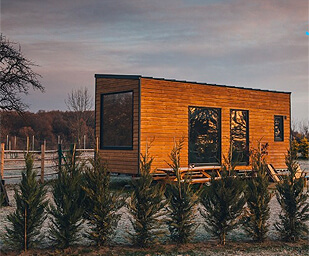A Guide to Choosing Land for Your Portable Home
- by Elite Portables
- 10 Feb 2021
- Blog

Getting the most out of your portable building means knowing how to choose the best land. There’s no point in giving your Elite Portables home a stunning view if the zoning rules will change to allow high-rises in your area in the future.
Go over our list of top considerations for choosing the best land.
Incline
One of the key considerations is topography or the shape of the land you’ll be building on.
Though sloped land is fine to build on, it’s not rocket science to know that the flatter the land, the easier and cheaper to build your portable building.
In many cases however screw piers can be drilled directly into sloped land without excavation and then the portable building can be lifted on to the piers and secured. This can often save a lot of money in the build process.
In the worst-case scenario however, the land may need excavation and this can be expensive.
Though building on high land may offer impressive views, flattening the land means blowing out your budget.
Soil
The soil also impacts how easy it is to build on the land.
Different types of soil affect how stable it is to support the weight of the portable building. Soil that is too hard or too soft both need excavation to create firm foundations.
Firm soil is especially important for sites that are close to water or prone to flooding. Meanwhile brownfield land, which used to be farmland but is now being developed, may be contaminated with pesticide and fertiliser residues.
Cover
Trees make a big difference to the construction project. They may restrict access to or around a site, drawing out the time for construction or even requiring specialist machinery.
Tree removal is another way to add to the cost of construction, and may require a regulatory permit, depending on the tree and local government area. Be careful about this one, as the land may be difficult to develop if you can’t secure the council permit for tree removal.
Roads
Having suitable road access is important, not only for how you’ll live in the portable building once it’s finished, but for bringing the materials in in the first place.
As the trucks will be carrying heavy loads of building materials, the roads need to be stable and wide enough for their access without tight corners or steep driveways.
Zoning
All land for development is regulated by zoning regulations.
Check to make sure the block you’re considering allows for residential development, including for any home renovations you may want in the future, such as granny flats, sheds or swimming pools.
It also pays to check that there are no special zones nearby that could place restrictions on building. These could include government land or infrastructure, airports, military sites, archaeological sites, heritage buildings, or environmentally sensitive land with protected ecosystems.
Utilities
Once the portable building has been built, it needs to be connected to water, electricity, internet and other utilities.
Ideally, these infrastructure connections already exist in the area. Otherwise, the cost will be higher to connect.
Choosing not to connect to existing utilities doesn’t necessarily lower the cost, as installing the equipment to live off-grid all come with their own regulations and price tags, from rainwater tanks to solar panels.
In this case, you’ll have to do the math to see if self-sufficiency works out to a financial advantage.
Ask the Experts
Not sure whether your site is suitable for a portable building? Ask the experts at Elite Portables.
Getting started is easy, check out our Price Guide
Elite Portables — your cost-effective home solutions. By working with Elite Portables, we ensure you only pay for what you need.

Driven by our Customer’s needs
“Fantastic service! I’m thrilled with my purchase and everything I asked for and changed as the construction progressed was catered to a high standard. I personally highly recommend Elite Portables team!”
Paul Brown | Pittsworth, QLD
“Excellent services and worked with me to tailor our little home to meet our needs. No issue was unfixable and that's appreciated big time with a building project. Standout team. ”
Georgina McGrath | QLD
“Elite Portables were fantastic! Our cabins are really well built and the staff very efficient and friendly. They quickly rectified any issues we had. We would happily recommend this company to anyone looking for a cabin. ”
Barbara Schaefer | QLD
Ready to get started? Contact our team today!
Company
Services
Get in Touch
16 Nans Road, Helidon Spa Qld 4344
1300 310 480
Monday - Friday: 7 am-4 pm
Saturday: 8 am - 12 pm
Sunday: Closed
info@eliteportables.com.au
Sitemap

© 2023 Elite Portables. All Rights Reserved. Website by Balar Media Group




